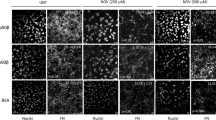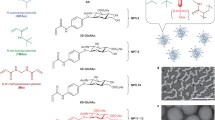Abstract
Purpose
To develop PEGylated variants of pUR4/FUD (FUD), a fibronectin assembly inhibitor, using 10 kDa, 20 kDa, and 40 kDa PEGs to evaluate their binding affinity and inhibitory potency.
Methods
The FUD peptide was recombinantly expressed, purified, and PEGylated at the N-terminus using 10 kDa, 20 kDa, and 40 kDa methoxy-PEG aldehyde. The PEGylates were purified and fractionated using ion-exchange chromatography. The molecular weight and degree of PEGylation of each conjugate was verified using MALDI-TOF. The binding affinity of each PEG-FUD conjugate was studied using isothermal titration colorimetry (ITC) and their inhibitory potency was characterized by a cell-based matrix assembly in vitro assay.
Results
The 10 kDa, 20 kDa, and 40 kDa PEG-FUD conjugates were synthesized and isolated in good purity as determined by HPLC analysis. Their molecular weight was consistent with attachment of a single PEG molecule to one FUD peptide. The binding affinity (Kd) and the fibronectin fibrillogenesis inhibitory potency (IC50) of all PEG-FUD conjugates remained nanomolar and unaffected by the addition of PEG.
Conclusions
Retention of FUD fibronectin binding activity following PEGylation with three different PEG sizes suggest that PEG-FUD holds promise as an effective anti-fibrotic with therapeutic potential and a candidate for further pharmacokinetic and biodistribution studies.







Similar content being viewed by others
Abbreviations
- 70 K:
-
70 kDa N-terminal region of fibronectin
- ECM:
-
Extracellular Matrix
- FN:
-
Fibronectin
- FNI:
-
Fibronectin type I domain
- FUD:
-
Functional Upstream Domain
- ITC:
-
Isothermal Titration Calorimetry
- MAA:
-
Matrix Assembly Assay
- MALDI-TOF:
-
Matrix Assisted Laser Desorption/Ionization Time of Flight
- PEG:
-
Polyethylene Glycol
- TGF-β:
-
Transforming Growth Factor β
References
Sottile J, Hocking DC. Fibronectin polymerization regulates the composition and stability of extracellular matrix fibrils and cell-matrix adhesions. Mol Biol Cell. 2002;13(10):3546–59.
Dallas SL, Sivakumar P, Jones CJP, Chen Q, Peters DM, Mosher DF, et al. Fibronectin regulates latent transforming growth factor-β (TGFβ) by controlling matrix assembly of latent TGFβ-binding Protein-1. J Biol Chem. 2005;280(19):18871–80.
Moore C, Shen X-D, Gao F, Busuttil RW, Coito AJ. Fibronectin-α4β1 integrin interactions regulate Metalloproteinase-9 expression in Steatotic liver ischemia and reperfusion injury. Am J Pathol. 2007;170(2):567–77.
Maurer LM, Ma W, Mosher DF. Dynamic structure of plasma fibronectin. Crit Rev Biochem Mol Biol. 2016;51(4):213–27.
Singh P, Carraher C, Schwarzbauer JE. Assembly of fibronectin extracellular matrix. Annu Rev Cell Dev Biol. 2010;26:397–419.
Schwarzbauer JE. Identification of the fibronectin sequences required for assembly of a fibrillar matrix. J Cell Biol. 1991;113(6):1463–73.
McKeown-Longo PJ, Mosher DF. Interaction of the 70,000-Mol-wt amino-terminal fragment of fibronectin with the matrix-assembly receptor of fibroblasts. J Cell Biol. 1985;100(2):364–74.
Tiwari A, Kumar R, Ram J, Sharma M, Luthra-Guptasarma M. Control of fibrotic changes through the synergistic effects of anti-fibronectin antibody and an RGDS-tagged form of the same antibody. Sci Rep. 2016;6:30872.
Maurer LM, Tomasini-Johansson BR, Ma W, Annis DS, Eickstaedt NL, Ensenberger MG, et al. Extended binding site on fibronectin for the functional upstream domain of protein F1 of Streptococcus pyogenes. J Biol Chem. 2010;285(52):41087–99.
Tomasini-Johansson BR, Kaufman NR, Ensenberger MG, Ozeri V, Hanski E, Mosher DF. A 49-residue peptide from Adhesin F1 of Streptococcus pyogenes inhibits fibronectin matrix assembly. J Biol Chem. 2001;276(26):23430–9.
Altrock E, Sens C, Wuerfel C, Vasel M, Kawelke N, Dooley S, et al. Inhibition of fibronectin deposition improves experimental liver fibrosis. J Hepatol. 2015;62(3):625–33.
Weinstock MT, Francis JN, Redman JS, Kay MS. Protease-resistant peptide design—empowering nature's fragile warriors against HIV. Pept Sci. 2012;98(5):431–42.
McGregor DP. Discovering and improving novel peptide therapeutics. Curr Opin Pharmacol. 2008;8(5):616–9.
Fishburn CS. The pharmacology of PEGylation: balancing PD with PK to generate novel therapeutics. J Pharm Sci. 2008;97(10):4167–83.
Tang L, Persky AM, Hochhaus G, Meibohm B. Pharmacokinetic aspects of biotechnology products. J Pharm Sci. 2004;93(9):2184–204.
Li W, Zhan P, De Clercq E, Lou H, Liu X. Current drug research on PEGylation with small molecular agents. Prog Polym Sci. 2013;38(3):421–44.
Tomasini-Johansson BR, Johnson IA, Hoffmann FM, Mosher DF. Quantitative microtiter fibronectin fibrillogenesis assay: use in high throughput screening for identification of inhibitor compounds. Matrix Biol. 2012;31(6):360–7.
Filla MS, Dimeo KD, Tong T, Peters DM. Disruption of fibronectin matrix affects type IV collagen, fibrillin and laminin deposition into extracellular matrix of human trabecular meshwork (HTM) cells. Exp Eye Res. 2017;165:7–19.
Lee S-H, Lee S, Youn YS, Na DH, Chae SY, Byun Y, et al. Synthesis, characterization, and pharmacokinetic studies of PEGylated glucagon-like Peptide-1. Bioconjug Chem. 2005;16(2):377–82.
Kinstler OB, Brems DN, Lauren SL, Paige AG, Hamburger JB, Characterization TMJ. Stability of N-terminally PEGylated rhG-CSF. Pharm Res. 1996;13(7):996–1002.
Guerra PI, Acklin C, Kosky AA, Davis JM, Treuheit MJ, Brems DN. PEGylation prevents the N-terminal degradation of megakaryocyte growth and development factor. Pharm Res. 1998;15(12):1822–7.
Kinstler O, Molineux G, Treuheit M, Ladd D, Gegg C. Mono-N-terminal poly(ethylene glycol)–protein conjugates. Adv Drug Deliv Rev. 2002;54(4):477–85.
Pasut G, Veronese FM. State of the art in PEGylation: the great versatility achieved after forty years of research. J Control Release. 2012;161(2):461–72.
Harris JM, Chess RB. Effect of pegylation on pharmaceuticals. Nat Rev Drug Discov. 2003;2(3):214–21.
Yamaoka T, Tabata Y, Ikada Y. Distribution and tissue uptake of poly(ethylene glycol) with different molecular weights after intravenous administration to mice. J Pharm Sci. 1994;83(4):601–6.
Rudmann DG, Alston JT, Hanson JC, Heidel S. High molecular weight polyethylene glycol cellular distribution and PEG-associated cytoplasmic Vacuolation is molecular weight dependent and does not require conjugation to proteins. Toxicol Pathol. 2013;41(7):970–83.
Wang Y-S, Youngster S, Grace M, Bausch J, Bordens R, Wyss DF. Structural and biological characterization of pegylated recombinant interferon alpha-2b and its therapeutic implications. Adv Drug Deliv Rev. 2002;54(4):547–70.
Bailon P, Palleroni A, Schaffer CA, Spence CL, Fung W-J, Porter JE, et al. Rational Design of a Potent, long-lasting form of interferon: a 40 kDa branched polyethylene glycol-conjugated interferon α-2a for the treatment of hepatitis C. Bioconjug Chem. 2001;12(2):195–202.
Ross RJM, Leung KC, Maamra M, Bennett W, Doyle N, Waters MJ, et al. Binding and functional studies with the growth hormone receptor antagonist, B2036-PEG (Pegvisomant), reveal effects of Pegylation and evidence that it binds to a receptor Dimer1. J Clin Endocrinol Metab. 2001;86(4):1716–23.
Bábíčková J, Klinkhammer BM, Buhl EM, Djudjaj S, Hoss M, Heymann F, et al. Regardless of etiology, progressive renal disease causes ultrastructural and functional alterations of peritubular capillaries. Kidney Int. 2017;91(1):70–85.
Ehling J, Bábíčková J, Gremse F, Klinkhammer BM, Baetke S, Knuechel R, et al. Quantitative micro-computed tomography imaging of vascular dysfunction in progressive kidney diseases. J Am Soc Nephrol. 2016;27(2):520–32.
MOSSMAN BT, CHURG A. Mechanisms in the pathogenesis of asbestosis and silicosis. Am J Respir Crit Care Med. 1998;157(5):1666–80.
Coughlin MK. Radial scars in benign breast-biopsy specimens and the risk of breast Cancer. AORN J. 2000;71(1):240–2.
Kenny HA, Chiang C-Y, White EA, Schryver EM, Habis M, Romero IL, et al. Mesothelial cells promote early ovarian cancer metastasis through fibronectin secretion. J Clin Invest. 2014;124(10):4614–28.
Cox TR, Bird D, Baker A-M, Barker HE, Ho MWY, Lang G, et al. LOX-mediated collagen crosslinking is responsible for fibrosis-enhanced metastasis. Cancer Res. 2013;73(6):1721–32.
ACKNOWLEDGMENTS AND DISCLOSURES
The MALDI-TOF MS and LC-MS analysis of FUD, mFUD, PEG-FUD, and PEG-mFUD was facilitated by Ian Miller, Molly Pellitteri Hahn, and Cameron Scarlett at the School of Pharmacy’s Analytical Instrumentation Center. We are grateful for the financial support of the University of Wisconsin-Madison School of Pharmacy and the National Institutes of Health Grant R01AI101157 to the Kwon lab and the National Eye Institute Grants EY017006 and EY0020490 (Peters lab), a Core grant to the Department of Ophthalmology and Visual Sciences P30EY016665 which provides support to the Peters lab.
Author information
Authors and Affiliations
Corresponding author
Electronic supplementary material
ESM 1
FPLC ion exchange chromatogram showing purification of the FUD and mFUD peptides. An anionic exchanger combined with a mobile phase gradient of 20 mM Tris A side and 1 M NaCl B side were used to elute and fractionate the peptides. (JPG 2018 kb)
ESM 2
FPLC ion exchange chromatogram showing isolation by fractionation of the 20 kDa PEG-FUD and 20 kDa PEG-mFUD constructs. An anionic exchanger combined with a mobile phase gradient of 20 mM Tris A side and 1 M NaCl B side were used to elute the peptide and separate it from unreacted FUD, PEG, and diPEGylated species. (JPG 2389 kb)
ESM 3
Reversed Phase High Performance Liquid Chromatography (RP-HPLC) chromatograph comparing retention times of FUD to mFUD and their respective PEGylates. The analysis was made using a C8 column combined with an A side H2O and B side acetonitrile mobile phase elution gradient. (JPG 2457 kb)
ESM 4
MALDI-TOF MS spectrum verifying the molecular weight of the 10 kDa PEG-FUD construct. A 6 kDa FUD reacted with a single 11.1 kDa nominal MW PEG yielded 16.9 kDa PEG-FUD. The analysis was made using α-cyano-4-hydroxycinnamic acid matrix. (JPG 2075 kb)
ESM 5
MALDI-TOF MS spectrum verifying the molecular weight of the 40 kDa PEG-FUD construct. A 6 kDa FUD reacted with a single 43.6 kDa nominal MW PEG yielded 49.6 kDa PEG-FUD. The analysis was made using α-cyano-4-hydroxycinnamic acid matrix. (JPG 2075 kb)
ESM 6
MALDI-TOF spectrum verifying the molecular weight of the 20 kDa PEG-mFUD construct. A 6 kDa mFUD reacted with a single 21.4 kDa nominal MW PEG yielded approximately 27.4 kDa PEG-mFUD. The analysis was made using α-cyano-4-hydroxycinnamic acid matrix. (JPG 1794 kb)
ESM 7
Determination of binding affinity (Kd) and other thermodynamic parameters using Isothermal Titration Calorimetry (ITC). All experiments were performed using pH 7.4 PBS, 25°C chamber conditions, and human plasma FN. A) 10 kDa PEG-FUD into FN and B) 40 kDa PEG-FUD into FN experiment sample isotherm and thermograph. Each experiment was repeated in triplicates. (JPG 6882 kb)
ESM 8
Matrix Assembly in vitro Assay (MAA) demonstrating inhibitory potency of FUD and 10 kDa, 20 kDa and 40 kDa PEG-FUD conjugates, and the 20 kDa PEG-mFUD control peptide. Human foreskin fibroblasts (AH1F) are grown in the presence of exogenous Alexa 488-labeled human plasma FN and in the presence or absence of an inhibitor. Results show parity of inhibitory potency between FUD and PEG-FUD conjugates. Extraction of IC50 values yielded A) 13 nM and 17 nM for FUD and 10 kDa PEG-FUD, respectively and B) 19 nM and 20 nM for FUD and 40 kDa PEG-FUD, respectively. For each data point, n = 4. (JPG 5221 kb)
Rights and permissions
About this article
Cite this article
Zbyszynski, P., Tomasini-Johansson, B.R., Peters, D.M. et al. Characterization of the PEGylated Functional Upstream Domain Peptide (PEG-FUD): a Potent Fibronectin Assembly Inhibitor with Potential as an Anti-Fibrotic Therapeutic. Pharm Res 35, 126 (2018). https://doi.org/10.1007/s11095-018-2412-7
Received:
Accepted:
Published:
DOI: https://doi.org/10.1007/s11095-018-2412-7




